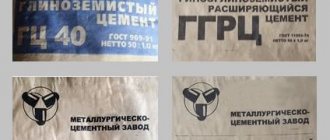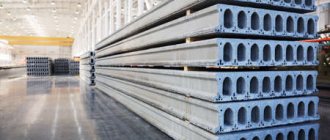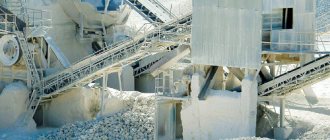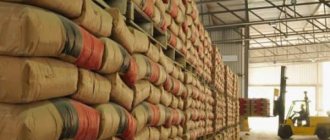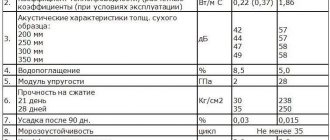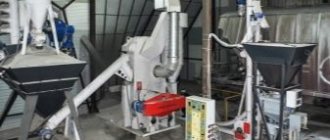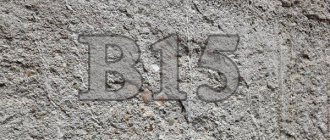Almost every construction process requires the use of masonry cement mortar. You can make it yourself, spending a certain amount of time and effort. Or you can purchase ready-made cement mixture.
There is a huge assortment of this material on the market and you can get confused before choosing it. After all, in order for the constructed structure not to collapse in the near future, but to serve for many years, you need to purchase the most suitable and high-quality masonry mortar. Therefore, before purchasing it, it is advisable to get to know it better and at the same time find out the price of this indispensable material for construction.
What is masonry cement mortar made from?
Ready-made cement mortar is a dry mixture that is used to fill all the free space between bricks, stone or concrete blocks and gives the resulting structure strength. It not only firmly holds all the elements together, but also does not allow cold and moisture to pass through and does not delaminate over time.
The main composition of the finished solution consists of:
- Aggregate (sand is most often used).
- The binder mixture is cement.
The ratio of these materials depends on the brand of masonry cement mixture.
What is added to the solution?
It is permissible to use various fillers and additives . It is difficult to list everything, because their number exceeds a hundred. But everything can be divided into groups that differ in their properties and purposes of application:
- To reduce hygroscopicity . These fillers reduce the porosity of the masonry material. The resulting mixture can be used for work in rooms with high humidity.
- To increase frost resistance . These additives make it possible to use the resulting mixture for external masonry work, since it will not be afraid of temperature changes.
- To increase strength .
- To increase ductility .
- To increase adhesion . Some masonry materials have poor “adhesion”; fillers in this group will help the masonry cement mixture adhere to them more easily.
Fillers and additives in the mixture can affect the amount of the main components. Some craftsmen try to improve the properties of the solution at home by adding lime, clay or salt to it. But it is very difficult to calculate the required amount of each material; incorrect calculation can lead to poor-quality masonry.
How to avoid cracks in cement-sand mortar
There are several reasons for the appearance of cracks; we will consider them separately.
Shrinkage cracks are one of the most common phenomena. In turn, they are preceded by two reasons: too much water has been added to the solution or the applied mixture dries out too quickly. And sometimes cracks form due to both reasons.
To avoid excess water, you need to make the thickest possible solution. Many people think that the liquid mixture will “stick” to the base better - this is true, but then there is a risk of cracks and the mixture will lose in strength (it will be too porous after drying). Therefore, you need to remember about the adhesive layer and spray - they solve the problem of “sticking”.
When the solution dries quickly, shrinkage occurs before the mixture reaches minimum strength - therefore, cracks form. Rapid drying can be prevented by abundantly moistening the base and periodically wetting the applied mixture.
I propose to end here, the article will be supplemented.
Sources:
GOST 30515-2013 Cements. General technical conditions
SP 82-101-98 Preparation and use of building mortars
What is important to consider when preparing it?
nuances in the correct preparation of ready-made masonry cement mixture, and here are the most basic ones:
- To prepare a ready-made masonry cement mixture, you need to pour water into the dry mixture and mix until a homogeneous mass is obtained. Before adding water, you must study the instructions; they indicate how much water to use.
- If possible, it is better to use tap water, since untreated water contains minerals that can change the characteristics of the solution for the worse.
- You can mix the mixture in a concrete mixer, trough or bucket.
If you decide to use a concrete mixer , you need to pour the finished mixture into the apparatus itself and turn it on. Then slowly pour in water, checking it periodically with a trowel.
If you use a bucket or trough, you need to purchase a hand mixer with a special attachment. The solution must be mixed well, otherwise an untouched dry mixture may remain at the bottom of the trough or bucket. You should not use a drill or hammer drill to stir the solution; a high-speed and expensive tool may fail.
You can prepare a cement mixture in the factory. This option is well suited for large-scale work, especially since the price is quite reasonable. Ready-made cement masonry mortar will be delivered in large quantities at the agreed time. But it must be used within 3 hours. Otherwise, losses cannot be avoided, because it hardens quickly.
Consumption 1 m2
To obtain the most accurate amount of solution with minimal errors, a step-by-step calculation of consumption should be used. To do this, you need to calculate the area of the masonry (minus window and door openings), and then calculate the amount of mortar based on a third of a cubic meter of mixture for each cubic meter of area.
For example, it is necessary to erect a one-story building with a wall length of 15 meters and a ceiling height of 3.4 meters. There are seven windows measuring 1.8 x 1.2 meters and two doorways measuring 2.1 x 1.3 meters. In this case, an independent calculation of masonry with an internal thickness of 25 centimeters and an external thickness of 64 centimeters will look like this:
- total volume of external walls: 4 (walls) x 3.4 m x 15 m – 7 (windows) x 1.2 m x 1.8 m – 2 (doors) x 1.3 m x 2.1 m) x 0.64 m;
- total volume of internal walls: 42m x 3.4m – 5 x 1.3 x 2) x 0.25m;
- calculation of the ratio of aggregates and binders 4:1;
- calculation of the amount of cement.
In the vast majority of cases, the solution is mixed in the following proportions:
- 1 part cement;
- 3 parts of sifted sand;
- ½ part water.
To prepare the most popular brands of mortar, the following proportions of sand and cement are recommended:
- for the manufacture of grade M25: 5 to 1;
- for the manufacture of grade M50: 4 to 1;
- for the manufacture of grade M75: 3 to 1.
For example, to prepare an M25 mortar, you need to mix 2 tons of sifted sand, 0.26 tons of M400 cement and add 350 liters of water. It is necessary to take into account that the ratio of components may vary depending on external factors, including the location of work and soil and climatic conditions.
Attention: To cover walls with clinker facing bricks, it is necessary to use compounds of high viscosity, which can be increased using ground slag.
The table below shows standard material consumption standards depending on the thickness of the brickwork:
| masonry thickness, cm | consumption for single brick, kg | consumption for one and a half bricks, kg | consumption for double brick, kg |
| 12 | 30 | 24 | 18 |
| 25 | 78 | 66 | 54 |
| 38 | 126 | 108 | 90 |
Types of masonry mortars and their characteristics
Cement masonry mortars are divided into two main types :
- Cement-lime . It is very plastic due to the lime contained in the mortar; it can be used for laying highly porous materials. If you add foam balls or expanded clay to such a solution, the thermal insulation properties of the finished structure will increase. But it is afraid of aggressive environments, so it is not recommended to use it for outdoor work. The physical functions of bonding the surface with cement-lime mortar are also reduced when ammonia and other acidic environments come into contact with it. It can be used to build internal partitions from foam concrete, sand-lime brick or gas-foam block.
- Cement-sand . This is the most common type of masonry mortar. It is used for laying bricks, gas-foam blocks, and concrete blocks. It is not afraid of exposure to aggressive environments and can withstand enormous pressure, due to which it is used even in the construction of multi-story buildings. Can be used both for external and internal work.
This solution also has disadvantages . It is not flexible enough, is unsuitable for laying highly porous materials, and also absorbs water, so it is not frost-resistant. But the use of additives can reduce porosity and increase service life.
All types of mortar are durable. But their durability depends on many environmental factors (temperature, humidity, etc.).
Mixing technology
The procedure for mixing the solution should be carried out in some spacious container. At the first stage, fill the container with water, and then gradually begin to add lime. After stirring, you should get milk of lime, to which sand is then added. The required masonry or plaster mortar for walls and bricks can also be prepared in another way - by adding water to the already mixed powder composition.
In mortars for plastering walls, an important component is fine-grained sand. Raw materials must be of the highest quality, and the components must be completely free of unnecessary impurities. The permissible rate of foreign substances cannot exceed 5%. The use of raw materials that contain clay significantly reduces the consumption of binder components, however, after such a coating dries, the material becomes covered with cracks.
When mixing plaster material for walls, you should carefully control the proportion of fine-grained sand, because an excess of silicate contributes to the fact that the consumption of the binder will be excessive and the material will be thicker than necessary, which will also inevitably lead to the formation of cracks after drying.
Lime mortar based on slaked lime is used in finishing rooms where there is high air humidity. Among other things, there is also hydraulic plaster, which hardens faster than a composition based on slaked lime. The advantages of this solution include a high degree of hydration, which is an excellent factor for using hydraulic plaster in winter.
If you set out to prepare a mixture for plastering walls on a cement base with the addition of lime, you should make sure in advance that there are three main components of the material:
- astringent substance, in this case cement and lime;
- in addition to the main substance, the cement-lime composition should also include a filler, mainly sand (the sand should be either fine-grained or quarry sand);
- water.
To prepare lime mortar, you will need cement grade M75, M50 or M25 according to GOST 28013-98. The possible downgrade of the cement grade depends on the storage conditions and the time that has passed since the package was opened. This is explained by the fact that the oxidation process, after a certain period, negatively affects the composition of the substance. When adding sand, careful attention should be paid to the purity of the silicate.
To achieve more even mixing, you should use a sieve. This is an important step because... Excessive filling of raw materials with undesirable elements can significantly reduce the quality of the prepared solution.
For better sifting, it is recommended to use a sieve with a mesh size of 3-5 mm.
In order to increase plasticity, you can add PVA glue in a ratio of approximately half a liter of glue per 20 liters of solution. Also, in some cases, it is possible to add liquid soap - as for budget options, with a more responsible approach to the preparation of masonry mortar for bricks, it is still better to add special plasticizers.
Since the solution is prepared using cement and lime, special attention should be paid to the quality of the second component. It may happen that the purchased lime turns out to be quicklime, so it is worth carrying out the slaking procedure, meeting the requirements for safe operation. This process involves loading raw materials into a container and filling it with water. During this procedure, very violent chemical oxidation reactions occur, which can result in the generation of large amounts of heat. To protect yourself, the procedure should be carried out wearing a mask and special glasses; you can use rubber gloves to protect your skin.
Application of masonry cement mortars
The finished solution is divided according to the most important characteristic - strength , which each brand has its own and which it acquires 4 weeks after installation at temperatures from 15 to 25 degrees. This mark indicates how much load the solution can withstand in compression. The load is calculated in kilograms per square centimeter. There are the following brands of ready-made masonry cement mixture: M50, M75, M100, M150 and M200, which have an appropriate cost.
The use of each brand of ready-made cement masonry mortar can be found in the table:
| Brand | Application in construction |
| M50 | Unable to withstand deformation . It can be used to smooth out uneven surfaces. |
| M75 | Designed for interior work: brick or stone laying. |
| M100 | Can be used for internal plastering of surfaces, floor screeds, external and internal masonry of stone bricks. Using plasticizers, external plastering of the surface is possible. |
| M150 | Designed for masonry , plaster, screed. You can work with highly porous materials and in damp rooms. |
| M200 | Rarely used in masonry, more often for flooring and foundation construction. It is not afraid of aggressive environments and has waterproofing properties. |
The range of ready-made masonry cement mixture is large, it is represented by both foreign and Russian manufacturers. For any type of work, you can choose a suitable cement mortar, the price of which is not so high. But remember that you need to purchase it from trusted suppliers who have a good reputation. After all, the quality of your finished structure depends on them.
How to determine the brand of cement?
The grade of cement is determined using special equipment in laboratory conditions, based on the strength of the sample. To do this, a test sample is taken, three parts of purified quartz sand are added to one part of the binder to obtain a test solution.
The mixture is thoroughly mixed with the addition of water, poured into 6-10 molds measuring 10x10x10 cm. The samples are kept for 28 days, during which it hardens to 98% of the calculated hardness. After this, a sample is selected, placed under a press, and the pressure at which it breaks is measured.
Measurements are carried out on six randomly selected samples. From these, 4 samples are selected with the highest pressure required for destruction, and the average value is calculated. Based on the results, the grade and strength class of cement is determined, respectively in MPa and kg/cm³.

